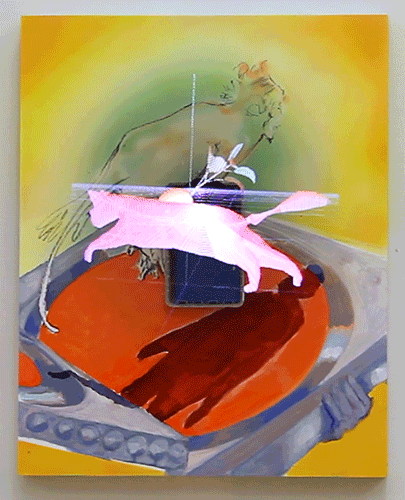Welcome to the fourth dimension
Exploring the limits between the experiential and the experimental with Rachel Rossin.
GIF: Courtesy of Rachel Rossin.
New York based artist Rachel Rossin creates imaginary digital worlds blending together images from art, history, popular culture, and modern technology in her virtual reality simulations. The images in her paintings are abstracted by computer programs that twist the inherent meaning of these seductive Internet renderings; which are mostly geared toward garnering clicks and game plays. Rachel has established herself as a pioneer of virtual reality art. Her practice is a perfect example of how artists are acting as early adopters of new processes, subverting, and co-opting technology for their own use. She combines Internet sources like video games and stock computer illustrations with objects from her day to day life such as a vase of flowers or a childhood drawing. Rossin has exhibited her virtual environments and paintings at art fairs in Miami, New York, and Seattle, as well as in group exhibitions at museums in Shanghai, Helsinki, and Pittsburgh.
In a conversation with her she told us her main influences, talked about her creative process and most importantly explained her relationship with technology and virtual reality.
Karen: You were raised in Florida, how has this city influenced your work?
Rachel: Well, I grew up in the typical American area in Florida where the suburbs meet the swamp so I spent a lot of time outside but mostly inside the Internet as a way to escape. I grew up online so that influenced my work a lot and I didn’t have access to the “art world” so my first introduction to ideas about art were through Manga, webrings, and DeviantArt.
Photo: Courtesy of Instagram @rachelrossin.
K: You are a multimedia artist and self-taught programmer, when did you start integrating technology to your paintings and artworks?
R: I started very young... My first memories of making art are drawing ontop of ascii printouts from a dot-matrix printer. My great grandfather was an autodidact and German-Jewish immigrant who was a mechanic for Burroughs adding machines that later became IBM. When he passed away, he left my mom all of his machines and they sat in our garage. Through his entire life he had collected all these machines that later on, when I was between three and four years old, I started using as drawing tools. But in a formal sense, I started when I was in college, making really bad AR experiments that were basically paintings that computers could recognize.
K: What type of experiences do you want people to have with your artworks?
R: I want them to have their own experiences… One of my favorite things about art is that I get to have a personal relationship with something someone left for me.
K: In 2019 you made a series of installed images in oil on canvas embedded in holographic displays. Could you tell us more about the creative process behind this works?
R: I was making paintings for digital spaces so I started embedding the hologram as a reference to those environments. Sometimes they are just annotations that I made of things that I would like to be on a painting and other times they are usually animations or works in 3D rendering programs or games.
GIF: Courtesy of Rachel Rossin.
K: Nowadays, what do you think our relationship with the virtual and with reality is?
R: I quarantined for three months by myself and I can’t imagine where my mental health would be without technology. I feel lucky that I had access to it. The downside is the exhaustion that comes from the one dimensional part of it. I used to spend time in the studio evenly split - either painting or doing something physical and equally in the virtual. As soon as the lockdown started I wanted to be in my body more, spending more time physically than virtually because so much of my social interactions were delegated to the screen. I think that technology throughout time has always acted as peripheral for human activity, because it extends our abilities. Technology used to just mean extending the body but new technologies have changed in that they are extending the space of cognition. Inevitably, devices will continue to have more access to us, our privacy because of the way they help us navigate, hold our memories and communicate with people. This is what I am anticipating and I hope that this progress is slow because, ethically, it is going to be very difficult.
K: I agree, it’s so easy to lose yourself in that.
R: Exactly, it’s the way dopamine is released and the way our brains can be so easily hacked that’s troubling. That’s why I would want technology to move slower, so we have time to adapt to it and have control over the way we digest it.
Photo: Courtesy of Rachel Rossin.
K: How important do you think videogames are? Do you consider them an art form?
R: I mean, of course in terms of entertainment, at the same level that big blockbuster or big film productions can be. Maybe it’s not art in the same way that visual art is, but it is an art form for sure.
K: Do you think that artists should question themselves about the possibility of integrating technology in their works of art?
R: No, my own feeling about this is that every idea dictates the medium. Why would I want to make a virtual reality world if I can make it like a movie? I don’t need to make a painting if it can exist as another medium. Especially if that’s not the language that you speak, then why would you need to superficially involve technology? It’s like this kind of force to approach, to try squeeze a medium into different-sized shoes. That’s not where the best art lives.
Video: Courtesy of Rachel Rossin.





